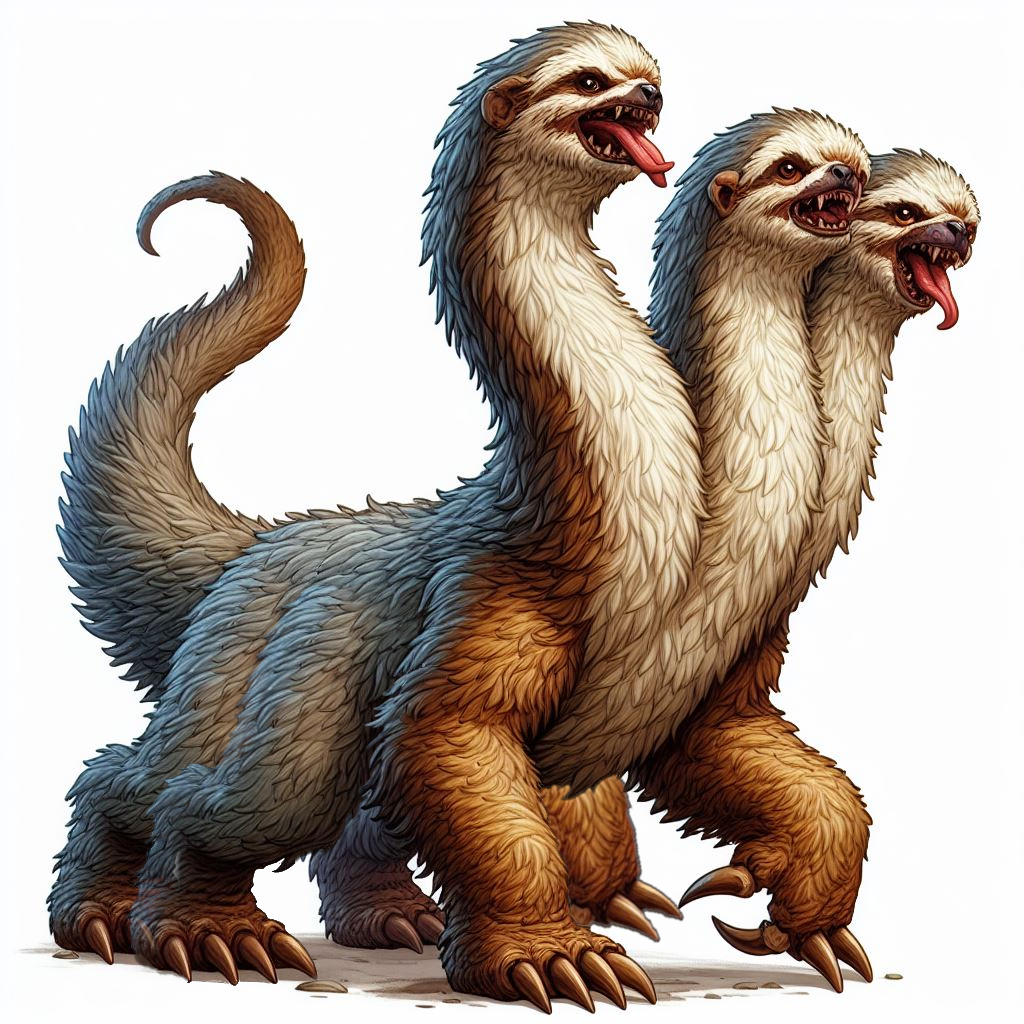Nightmare Sloth
Generated by ChatGPT, edited and recontextualized by Brandon VanGenderen
[Narrator’s Voice]
Deep within the heart of the dense forests of Tria's Impenetrable Hinterland lurks a creature of both wonder and terror. This is the domain of the formidable Terribilis Somniferoculus Tridens, a marvel of evolution and an apex predator unlike any other. Standing at a formidable nine feet from snout to tail tip, this monstrosity reigns supreme in its arboreal kingdom. Local colonists beware, the Nightmare Sloth.
As the name suggests, the Nightmare Sloth is no ordinary sloth. Its monstrous physique includes three sloth-like heads, each perched at the end of a sinuous neck that extends several feet from its muscular shoulders. Each head is equipped with keen eyes that gleam with an eerie intelligence, capable of peering through the densest foliage and the darkest shadows. This unique ability, known to the local inhabitants as "truesight," allows the Nightmare Sloth to see through illusions and other visual distortions, a symbiotic power likely derived from its diet of symbiote-infused flesh.
The creature's six powerful legs, each ending in razor-sharp claws, grant it unparalleled agility and strength in navigating the towering canopy. Unlike its lethargic, herbivorous cousins, the Nightmare Sloth is a creature of nightmarish aggression and carnivorous appetite. It prowls the treetops with silent precision, its movements a deadly ballet of stealth and power.
[Camera pans through the dense foliage, revealing the shadowy silhouette of the Nightmare Sloth as it navigates the branches]
The Nightmare Sloth's hunting strategy is a masterclass in predatory adaptation. Its three heads work in perfect unison, scanning the environment from multiple angles, ensuring that no potential prey escapes its notice. Each head is equipped with a mouthful of serrated teeth, capable of tearing through flesh with ease. When a target is identified, the Nightmare Sloth strikes with blinding speed, its multiple necks darting forward like coiled springs.
Its diet is diverse and gruesome. The Nightmare Sloth preys upon other arboreal creatures, from small mammals and birds to the occasional unfortunate primate. It has a particular penchant for eggs, often raiding nests with merciless efficiency. The symbiotic power of truesight allows it to detect the faintest signs of life, making it nearly impossible for potential prey to hide.
But the Nightmare Sloth is not merely a brute force predator; it is also a creature of strategy and cunning. It uses its environment to its advantage, often lying in wait near the nesting sites of its preferred prey. Motionless and patient, it becomes nearly indistinguishable from the surrounding foliage, a living nightmare lurking just out of sight.
[Close-up of the Nightmare Sloth’s heads, each one turning independently as it surveys its surroundings]
The three heads of the Nightmare Sloth are not just for hunting. They also serve as a formidable deterrent against the innumerable threats that arise from the Hinterland. When confronted, the creature can rear up on its hind legs, spreading its forelimbs wide and hissing menacingly. This display, combined with its terrifying appearance, is usually enough to send even the bravest of predators fleeing in terror.
Its aggressive nature is not confined to hunting. The Nightmare Sloth is fiercely territorial, defending its chosen patch of the forest with unmatched ferocity. Intruders are met with swift and brutal retribution, ensuring that the Nightmare Sloth maintains its dominance over its arboreal realm.
The reproductive habits of the Nightmare Sloth remain shrouded in mystery, a testament to the creature's elusive nature. Some believe that they are solitary creatures, coming together only for brief mating encounters high in the treetops although recent evidence points to Nightmare Sloths forming intensely strong attachments to their partners, despite living apart for long periods of time. The females are thought to give birth to a single offspring, which clings to its mother’s back until it is old enough to fend for itself. This period of maternal care is brief but passionate, with the mother fiercely protecting her young from the myriad dangers of the rainforest.
[A mother Nightmare Sloth seen from afar, her single offspring clinging to her back]
Despite its fearsome reputation, the Nightmare Sloth plays a crucial role in the delicate balance of its ecosystem. By controlling the population of smaller arboreal creatures, it prevents overgrazing and maintains the health of the forest canopy. Its predation on eggs ensures that no single species dominates, promoting biodiversity within its territory.
[The camera pans out, showing the dense canopy of a Hinterland rainforest, with the distant silhouette of the Nightmare Sloth blending into the twilight]
Scientific Name
Terribilis Somniferoculus Tridens
Geographic Distribution
Remove these ads. Join the Worldbuilders Guild




Comments